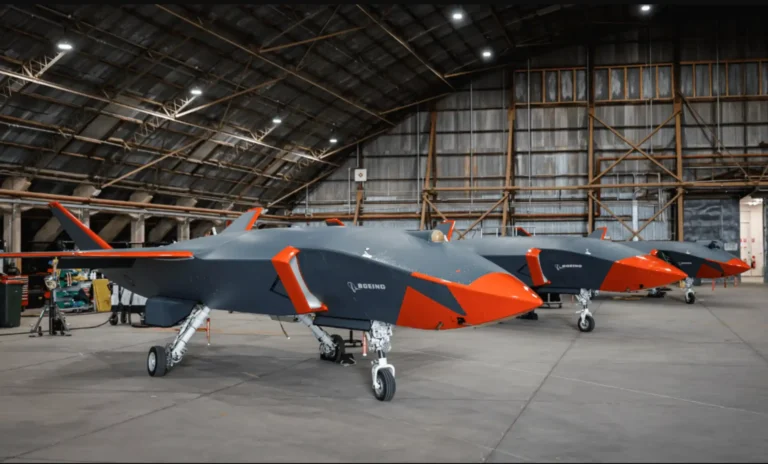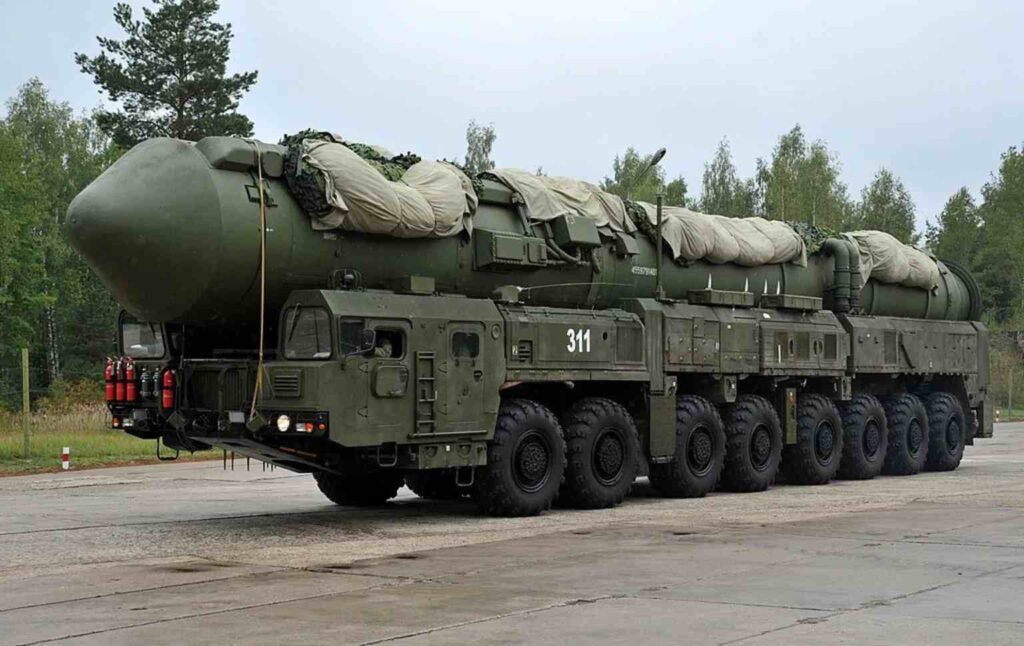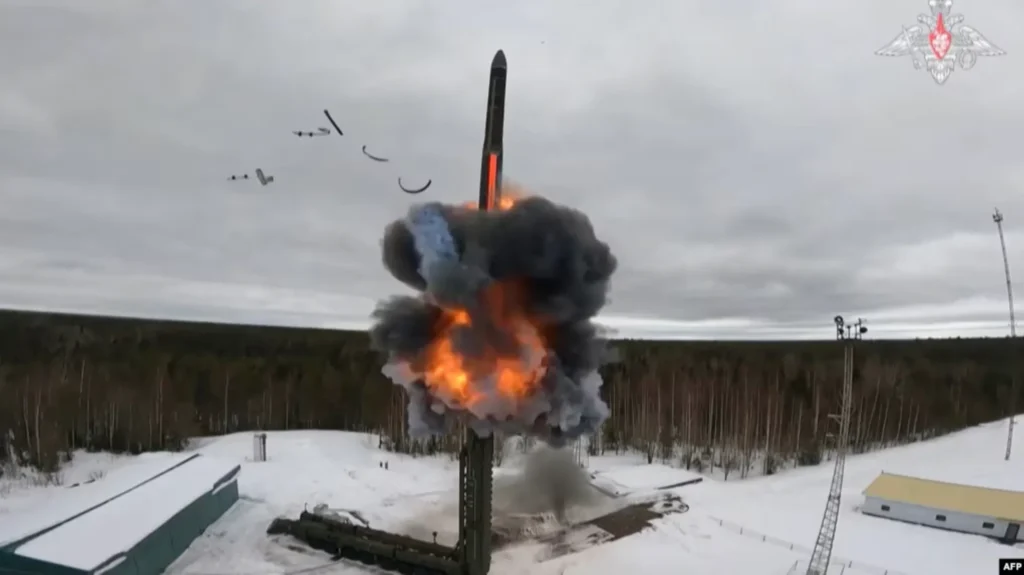Follow Us:

Share
The Oreshnik Missile (Russian: Орешник, meaning “Hazel tree”) is Russia’s latest intermediate-range ballistic missile (IRBM), a technological marvel designed to push the limits of modern military capabilities. With reported speeds exceeding Mach 10 (12,300 km/h or 7,610 mph), the Oreshnik has quickly garnered international attention for its advanced features, strategic implications, and potential to reshape the global defense landscape.

This missile made headlines following its confirmed operational debut during the Russo-Ukrainian War, solidifying its position as a cornerstone of Russia’s evolving military strategy. Here’s an in-depth look at the Oreshnik’s origins, capabilities, and the impact it may have on modern warfare.
The Oreshnik missile builds upon the foundation of the RS-26 Rubezh, a quasi-ballistic missile previously developed by Russia. According to defense analysts, the Oreshnik retains much of the Rubezh’s architecture, with approximately 90% of its components carried over.

However, the addition of new technology, such as advanced guidance systems and a MIRV payload (multiple independently targetable reentry vehicles), elevates its effectiveness and adaptability in combat scenarios.
The missile’s hypersonic capabilities make it significantly faster than traditional ballistic missiles, and its ability to travel through the upper atmosphere enables it to evade existing air defense systems. These advancements have positioned the Oreshnik as a key asset in Russia’s hypersonic arsenal, further bolstering its reputation as a leader in missile technology.
Read also: RS-24 Yars ICBM: Russia’s Ultimate Nuclear Deterrent
The Oreshnik made its operational debut on 21 November 2024, targeting Ukraine’s PA Pivdenmash facility in Dnipro. Initial reports speculated that an intercontinental ballistic missile (ICBM) had been used in the attack.
However, subsequent analyses identified the weapon as the Oreshnik. The strike is believed to have originated from Astrakhan Oblast, likely the Kapustin Yar training ground, a major testing site for Russian missiles.
Notably, the attack raised questions about the missile’s intended purpose. While some reports suggested that the Oreshnik carried a MIRV payload, others speculated that the strike lacked explosive warheads and served instead as a political demonstration of Russia’s technological capabilities. This ambiguity underscores the missile’s role not just as a weapon but also as a tool of psychological warfare.
Read also: RS-28 Sarmat “Satan 2”: Russia’s Most Feared ICBM
One of the Oreshnik’s most distinguishing features is its hypersonic speed, exceeding Mach 10. This incredible velocity makes it one of the fastest missiles in operation today, capable of reaching its target in minutes. This speed, combined with advanced navigation systems, significantly reduces the reaction time available to opposing forces.
The missile’s MIRV payload allows it to deploy multiple warheads, each capable of targeting different locations. This increases its destructive potential and complicates interception efforts. Unlike conventional missiles, the Oreshnik’s warheads can independently adjust their trajectories mid-flight, further enhancing their ability to evade defense systems.
The Oreshnik is designed to operate in the upper atmosphere, a region where traditional air defense systems are less effective. Ukrainian military officials have noted that the missile is effectively undetectable by existing radar systems, rendering interception nearly impossible.
🇺🇦⚔️🇷🇺
— Batu Han (@19BaTHaN19) November 22, 2024
The image created in the atmosphere by the Oreshnik intercontinental ballistic missile that #Russia hit #Ukraine with caused fear and panic in those who watched it.#UkraineWar#UkraineRussiaWar️️pic.twitter.com/GefJrUKGbx
According to the Center for Strategic and International Studies (CSIS), the Oreshnik represents a significant challenge for countries relying on legacy air defense technologies.
Eyewitnesses to its deployment in Ukraine reported prolonged explosions lasting up to three hours, suggesting a devastating level of destructive power. This aligns with reports that the Oreshnik’s warheads contain submunitions, which further amplify its impact.
Despite its advanced features, the Oreshnik is still considered to be in an experimental phase. U.S. defense officials believe that Russia possesses only a limited number of these missiles, making widespread deployment unlikely in the near term. This limited availability, combined with its experimental status, suggests that the Oreshnik’s initial use was as much a symbolic act as a tactical one.
Russian President Vladimir Putin has emphasized the missile’s strategic importance, announcing plans to begin mass production on 22 November 2024. This move signals Russia’s commitment to expanding its hypersonic capabilities and maintaining a competitive edge in the global arms race.
The Oreshnik represents a significant shift in the global military landscape. Its combination of speed, maneuverability, and payload capacity challenges the effectiveness of traditional air defense systems, raising critical questions about the future of missile defense.
In the context of the Russo-Ukrainian War, the Oreshnik’s deployment marks an escalation in the conflict. Its use against high-value targets, such as the PA Pivdenmash facility, demonstrates Russia’s willingness to leverage advanced technology to achieve strategic objectives. However, its experimental status and limited availability may constrain its impact on the broader war effort.
On a global scale, the Oreshnik highlights the growing importance of hypersonic weapons in modern military strategy. Countries such as the United States and China are already investing heavily in similar technologies, signaling the beginning of a new arms race. For Russia, the Oreshnik serves as both a deterrent and a statement of technological prowess, reinforcing its position as a major player in the hypersonic domain.
The Oreshnik missile is more than just a weapon; it’s a symbol of the next generation of warfare. With its hypersonic speed, advanced payload capabilities, and near-immunity to interception, it represents a profound challenge to traditional military paradigms. While its current use remains limited, its potential to influence the future of conflict is undeniable.
As Russia moves toward mass production, the Oreshnik will undoubtedly become a key element of its strategic arsenal. For military analysts and policymakers worldwide, understanding and countering the capabilities of this missile will be a top priority in the years to come.
Share
Defense Feeds is publication focusing on informing, engaging, and empowering the world by providing accurate information from defense technology.
Powered by Defense Feeds © 2025 – All rights reserved.